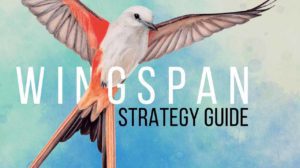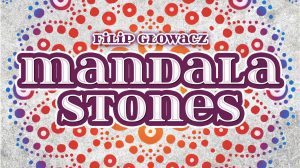Disclosure: Meeple Mountain received a free copy of this product in exchange for an honest, unbiased review. This review is not intended to be an endorsement.
Overview
The Rhine River (Rhein in German) stretches from Basel, Switzerland through a large portion of Europe before emptying out into the North Sea. Long considered one of the most important industrial trade routes in the world, it becomes a focal point in Devir’s new game Rhein: River Trade. The game is played over the course of 7 to 10 rounds. In each round players will take turns selecting orders, loading cargo, moving transports, and unloading cargo in an effort to fulfill all of their orders to make money. Sounds easy, doesn’t it?
Nothing’s that easy and moving your cargo up the Rhein is no different. Each order has a timer. Fail to deliver the goods before the time runs out and it’ll cost you. Hiring transports to move your cargo costs money and the transports can only move a certain number of spaces on each turn. Each transport also has a limited amount of cargo space. Wait too long and the transport you were hoping to use may no longer be available. When the last round is completed, the player who has managed to acquire the most capital will be the victor.
Meeple Mountain was provided with a review copy of this game by the publisher.
Components
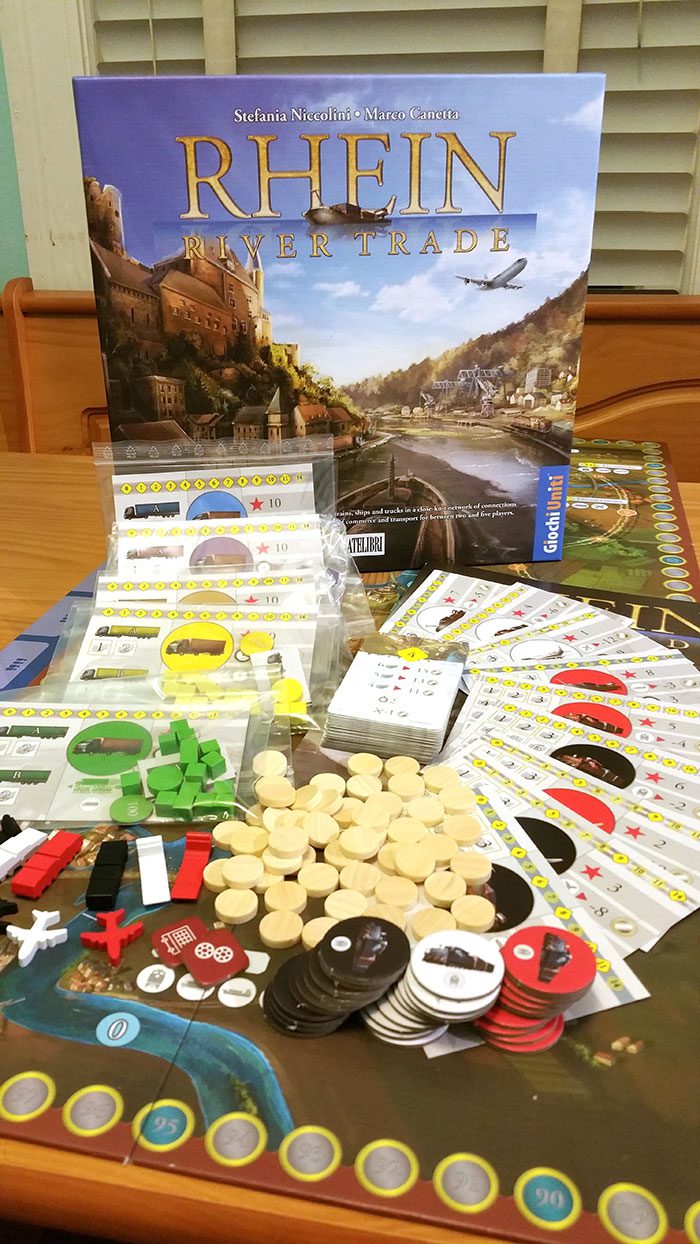
Hiding beneath the cover of Rhein: River Trade are a multitude of various pieces: nondescript wooden “time tokens”, small cargo cubes in five different colors (one for each player), a deck of Order cards, a phase counter, a round counter, scoring markers, the game board, four player boards, a rule book, and the various transportation pieces. There are two truck tokens in each color and each of the other transports comes with its own Transport Mat which provides stats for the various types of transport. For each type of transport other than the trucks, there are also a number of Reservation Markers as well as a nifty little wooden Transport meeple.
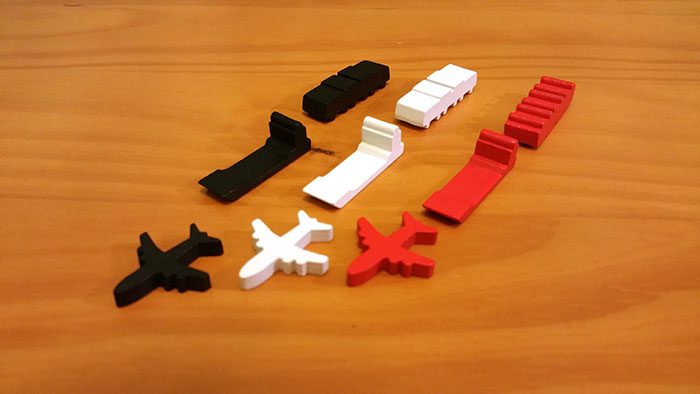
The game board displays an overhead view of the cities up and down the Rhein. At the bottom is Basel and at the top is London. Each city is accompanied by an orange square with a number in it. This number becomes important later on when we get to the Order cards, but these numbers also serve as a reminder of the order in which each of the various transports will encounter the various cities. The game board is broken up by four different travel tracks: a winding road on which the trucks can travel, the river itself for the boats, a railway for the trains, and a contrail which the planes follow. Each city name is accompanied by several small icons which show the types of transports that can access the city in question.
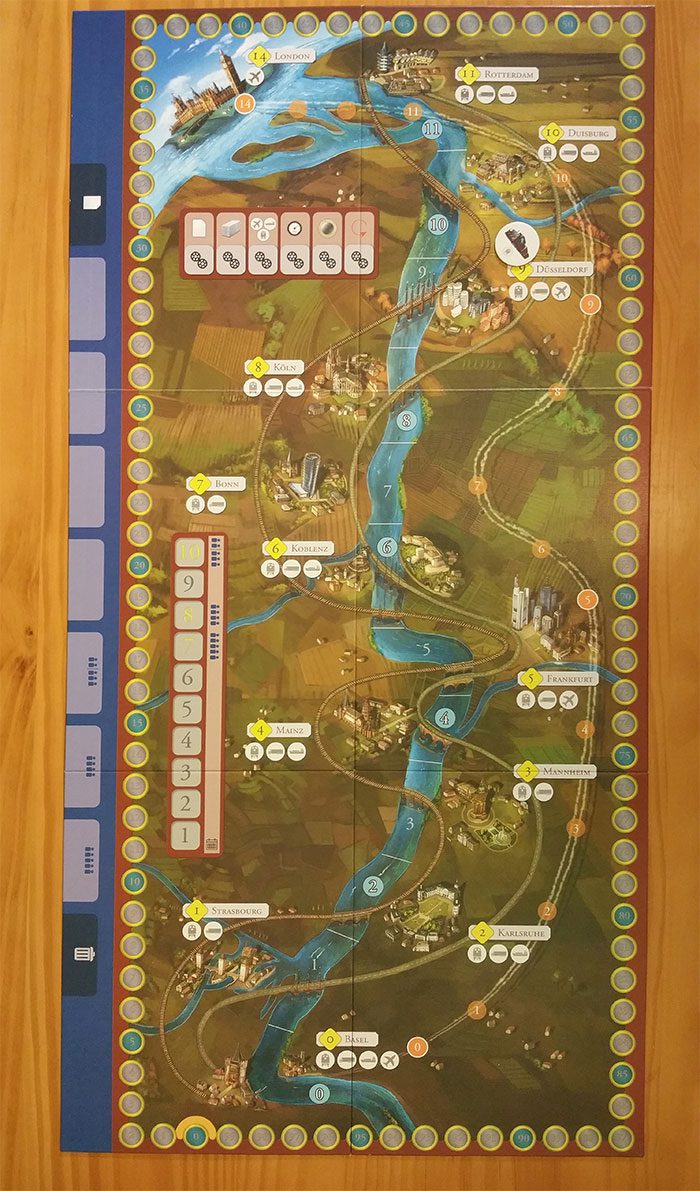
Along the outer rim of the game board is a track where players will mark their earnings and expenditures. There are two other tracks printed on the board: a numbered track which keeps track of the current round, and a track which lets the players know which phase of the turn they are currently in.
The Transport Mats display a list of all of the cities across the top. The highlighted ones show the cities that specific Transport can access. Below this is a picture of the Transport. To the left of this is the cargo area. Some of these cargo spaces have a black outline around them which signifies how much cargo must be loaded onto a transport before it can move.
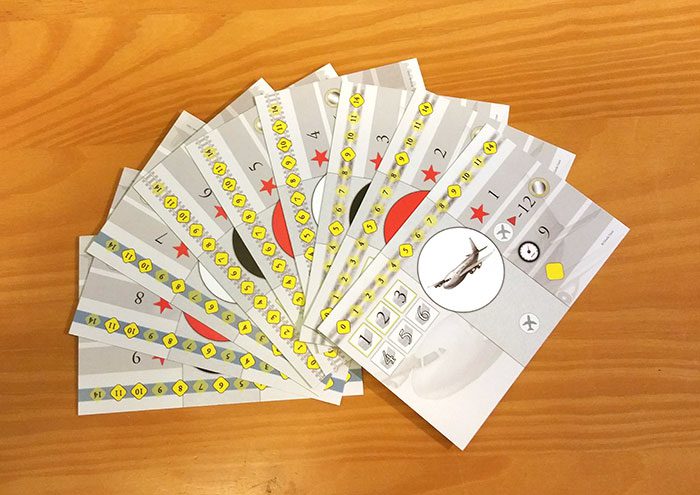
To the right of the Transport picture is a section that provides information about the transport. The red star with a number next to it signifies the Transport’s movement initiative (the order in which it moves). Beneath this is the Reservation cost (how much it costs to hire the vehicle to carry cargo for you) followed by the Transport’s maximum movement. Finally, there will be a number of yellow squares that tell you how many stops the Transport can make during a single movement.
The player board closely resembles the Transport maps with a few differences. To the left of the transport’s image are two different truck locations. Each of these has space for two cargo cubes. Trucks don’t require Reservations to move which means their movement cost looks slightly different.
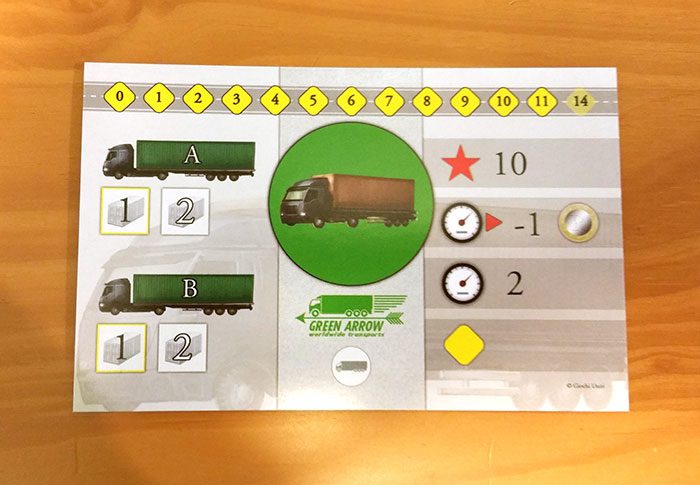
Last but not least are the Order cards. Each Order card lists several different contracts and the rewards for fulfilling each one of them. There is also an area that shows you how much time you have to complete the order and the penalty for being unable to do so. Finally, at the top of each of these cards is a yellow square with a number corresponding to one of the cities on the game board. This tells you where the order must be delivered. While most of the components in this game are of pretty decent quality, the cards and the various Transport and player boards feel very cheaply made. They are very thin and flimsy and I can easily see the quality of these pieces suffering over the course of multiple plays, so be forewarned.
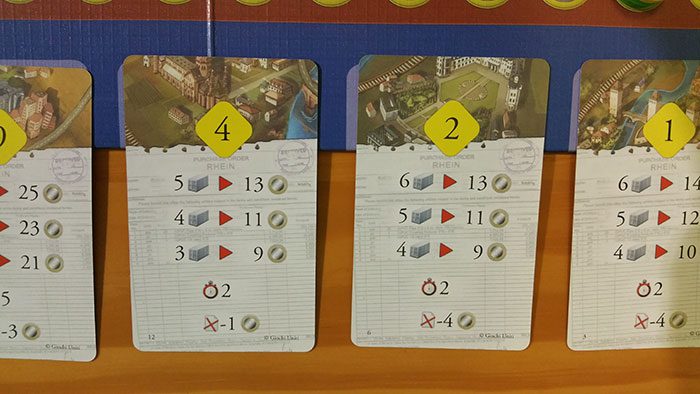
Setup
To set up a game of Rhein: River Trade, the board is laid out in the middle of the table with the various Transport mats laid out along the bottom of it (I recommend laying them out in order of their initiative). The Order card deck is shuffled and a few orders are laid out face up along the edge of the game board that has been set aside for that. The Reservation tokens are separated by transport type and placed onto the appropriate Transport mats. The phase counter is placed onto the first stage of the phase track and the turn counter is placed onto the space for round 1.
Each player receives the pieces of their chosen color, placing their scoring markers on top of the 20 space of the capital track in a randomly selected order. The players will place their player boards in front of them with their cargo cubes and truck tokens off to the side. The Time counters are placed into a pile within easy reach of all players. With this completed, the game is ready to begin.
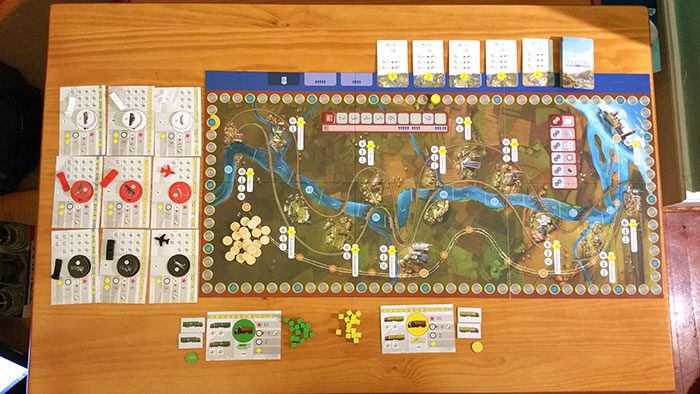
Anatomy of a Round
Rhein: River Trade takes place over 7 to 10 rounds determined by player count. Each round is broken into several distinct phases. During each of these phases, the person that is at the lowest point on the capital track will go first. In the rare instance that two people are tied for lowest, the piece on top of the stack goes first. Then the person who is second lowest, third lowest, etc. As the players move from one phase to the next, the phase counter moves accordingly. The phases are:
Take Orders: The players will take turns selecting an Order card (if they choose to) and taking the card into their possession. A number of Time counters are placed onto the selected Order card equal to that card’s Time value.
Load Goods: The players will take turns loading their cargo onto the various Transports. Loading a single cargo cube costs a single capital. Once a player has finished loading their cargo, the next player in line does the same.
Reserve Transport Stops: In turn order, the players take turns paying capital to reserve a stop in a particular city for a specific transport. This accomplishes two things. First, it guarantees that the transport in question will stop at the selected city instead of moving right past it. Second, it causes the transport to move in the first place. Unless there is a Reservation marker on the board for the particular transport, that transport will not leave Basel.
Move and Unload Transports: In order of initiative, every eligible transport will begin moving from Basel across the board. A transport is eligible if it has the required amount of cargo, and has a Reservation token for it on somewhere on the board. If the transport encounters a Reservation marker during its movement, it will come to a stop in that city and any player with cargo on that transport will have the opportunity to unload. If the transport has reached its maximum movement OR its maximum amount of stops, the movement for that transport will come to a halt. Otherwise, the transport will continue moving its maximum number of spaces.
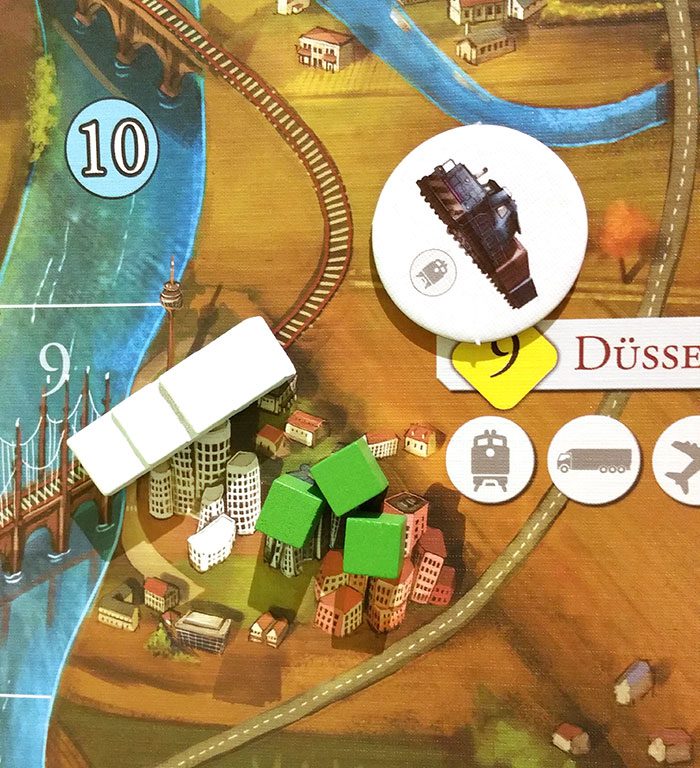
Fulfill Orders: After all of the transports have completed their movement and players have unloaded cargo, then the players will, in turn order, take turns fulfilling contracts. The cargo cubes used to fulfill the contracts are returned to the player and they move their scoring marker up the capital track for each completed Order card. The Time counters are returned to the general supply and the Order card is flipped over to signify that is has been completed.
End of Round: The phase counter is returned to the first position and the unclaimed Order cards are removed to the discard area. Any players with empty trucks on the board return those truck tokens to their supply. Any transports that are in Basel and have cargo on them are immediately unloaded. Any empty transports on the board which do not have existing Reservation markers on the board are returned to their matching Transport mat. Each existing Order card has one Time token removed from it. If this causes the Order card to have zero Time tokens onto it, then the owner of the card pays the penalty and discards the card. If a player has any cargo unloaded into any of the cities on the board, that player loses 1 capital per cargo cube that have been unloaded in this way. Then the turn tracker slides up to the next turn unless this was the last turn. In that case, the game comes to an end and scoring begins.

Endgame
At the end of the game, players will lose additional capital if they have any leftover unfulfilled Order cards, cargo cubes on any transports, or trucks that are still mortgaged (you can flip a truck token over and mortgage it for some quick cash if you get into a bind). The player with the most capital at the end of the game is the winner.
Final Thoughts
Let’s talk about what I thought of the game. Like any game, it has highs and lows. As I mentioned earlier, the quality of the cards and the various Transport mats and player boards leaves a lot to be desired. They are very thin and incredibly flimsy. It is no great stretch of the imagination to envision what they will probably look like after ten or twenty plays … worn out and fading. I certainly hope that future editions of the game utilize better materials during the manufacturing process (thicker card stock, linen finish, thicker mats, etc.).
Another negative that hit me right out of the box was a lack of plastic storage bags. I dislike having loose tokens and chits hanging around in my game boxes and it’s unfortunate when a game manufacturer neglects to include any kind of storage solution with their game. Fortunately for me, I had a lot of extra baggies laying around so I was able to address this problem rather easily, but not everyone has that sort of thing lying around, and they shouldn’t have to. It should just be standard to have a few baggies included.
Last but not least, while I like the artwork in the game (Mirco Paganessi has done a very good job at bringing the Rhein river valley to life), there’s just not enough of it. There’s a lot of negative space in this game and it practically glares at you from the illustration on the back of the box. If I’d come across this game in my local game shop, I probably would have discounted it out of hand due to its lack of visual appeal.

And that would have been a shame because it’s actually a really good game.
Rhein: River Trade is a game all about tough choices and it can be very difficult to get ahead if you plan poorly. When the game begins, you’ll most likely find yourself face to face with a lot of Order cards that you have no hope of fulfilling within the first couple of turns. This means that your total capital is going to be depleted for some time before you ever see a return on your investment. This can be particularly frustrating if your opponents are actively working to make it impossible for you to fulfill your Orders in time. So you’re forced to either take a gamble right out of the gates or to patiently wait for a better opportunity to come along.
Here’s an example of the kind of decision making you might encounter during a typical play. Let’s assume that one of your opponents has grabbed up an Order card to deliver goods to London that has a very large payout of 25 capital. If they were to take the airplane, they could conceivably make it to London in two turns provided nobody throws a wrench into their plans. So now it’s your turn to draft an Order card. There are a couple of decent ones out there, but none with a payout like the one that your opponent grabbed.
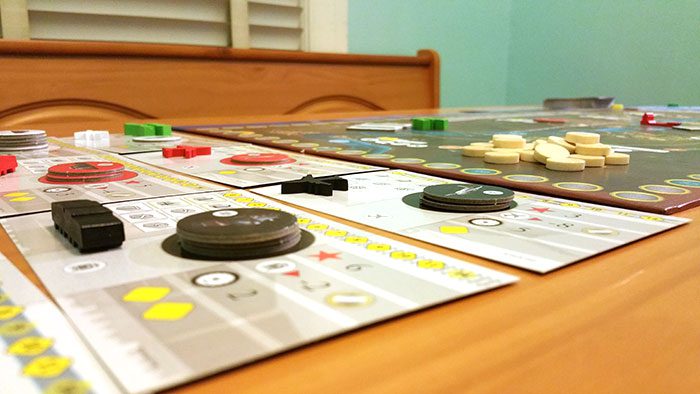
At this point, do you grab an Order card for yourself and focus on improving your own lot or do you divert your resources towards hampering your opponent’s effort? It is entirely possible that you could pointlessly load your own cargo onto the planes without a Reservation token (or get the other players to team up with you) in an effort to keep the planes grounded and deny your opponent the 25 capital. But, it’s also possible that you’d strike a gentleman’s agreement, load your cargo onto the plane, and then have your opponents welch on their part of the bargain. Decisions and calculations like these abound. Everything in this game requires a delicate assessment of risk versus reward.
It is this rich decision making, scheming, and calculating that keeps me playing. The negatives that I pointed out are mild annoyances at best and the outstanding quality of the game play definitely trumps them. Rhein: River Trade is an excellent game. If you’re considering taking a chance on it, then I highly recommend you take the plunge. You won’t be sorry you did.
What do you think about Rhein: River Trade? Give us your opinions about what you like and/or dislike about the game in the comments below!




